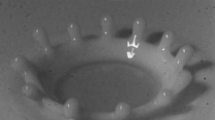Abstract
The general role of control windows is investigated by an assessment of the fundamentals of continuum dynamics in the spacetime context. The momentum rate of change of a continuous body is evaluated with reference to a control window travelling in the spacetime trajectory manifold. The resulting formula involves the rate of change of the momentum in the control window and the rate of outflow of the momentum across the control window boundary. An effective tool for investigating challenging dynamical problems is thus available, and some interesting examples, taken from early and recent contributions, are illustrated. Among these, motions of chains falling under the action of gravity, object of several investigations in the past two centuries, are revisited. Around the middle of the nineteenth century, the problem was inserted as a daring task in the Mathematical Tripos at Cambridge. The choice of a special control window, named the skeleton, in motion with the solid case, provides the proper methodology for the formulation of solid–fluid interaction problems, with applications to turbines, jets, rockets and sprinklers. As a further significant application of travelling control windows, a variational formulation of conservation of mass is developed and shown to yield the notion of mass flow vector field, with applications in problems of fluid flow through a porous solid.
Similar content being viewed by others
References
Cayley, A.: On a class of dynamical problems. Proc. R. Soc. Lond. VIII, 506–511 (1857)
Irschik, H.: The Cayley variational principle for continuous-impact problems: a continuum mechanics bases version in the presence of a singular surface. J. Theor. Appl. Mech. 50(3), 717–727 (2012)
Tait, P.G., Steele, W.J.: A Treatise on Dynamics of a Particle, 4th edn, pp. 250–251. MacMillan & Co, London (1856)
Hamel, G.: Theoretische Mechanik. Grundlehren der Mathematischen Wissenschaften. Bd LVII. Springer, Berlin (1949)
Gantmacher, F.R.: Lectures in Analytical Mechanics. Mir publishers, Moscow (1970)
Meirovitch, L.: Methods of Analytical Dynamics. McGraw-Hill, New York (1970)
Rosenberg, R.M.: Analytical Dynamics of Discrete Systems. Mathematical Concepts in Science and Engineering, vol. 4, 3rd print. Plenum Press, New York (1991)
Huang, Z.: The equilibrium equations and constitutive equations of the growing deformable body in the framework of continuum theory. Int. J. Non-Linear Mech. 39, 951–962 (2004)
de Sousa, C.A., Gordo P.M., Costa P.: Falling chains as variable mass systems: theoretical model and experimental analysis. arXiv:1110.6035 [pdf] (2011)
Gardi, E.: Lecture 6: Momentum and variable-mass problems. The University of Edinburgh, School of Physics and Astronomy. http://www2.ph.ed.ac.uk/~egardi/MfP3-Dynamics/Dynamics_lecture_6.pdf (2014)
Irschik, H., Holl, H.J.: Mechanics of variable-mass systems-part 1: balance of mass and linear momentum. Appl. Mech. Rev. 57(2), 145–160 (2004)
Irschik, H., Belyaev, A.K.: Dynamics of Mechanical Systems with Variable Mass. CISM Courses and Lectures, vol. 557. Springer, Wien (2014)
Irschik, H., Casetta, L., Pesce, C.P.: A generalization of Noether’s theorem for a non-material volume. Z. Angew. Math. Mech. 96(6), 696–706 (2016)
Romano, G., Barretta, R., Diaco, M.: Solid–fluid interaction: a continuum mechanics assessment. Acta Mech. 2283, 851–869 (2017)
von Buquoy, G.: Analytische Bestimmung des Gesetzes der virtuellen Geschwindigkeiten in mechanischer und statischer Hinsicht. Leipzig: bei Breitkopf und Härtel (1812). https://doi.org/10.3931/e-rara-14843
von Buquoy, G.: Exposition d’un nouveau principe général de dynamique, dont le principe des vitesses virtuelles n’est qu’un cas particulier. Courcier, Paris (1815)
Meshchersky, I.V.: The dynamics of a point of variable mass. Dissertation, St Petersburg Mathematical Society (1897)
Meshcherky, I.V.: Works on the Mechanics of Bodies with Variable Mass [in Russian], with an Introduction by A.A. Kosmodemyansky, Moscow, Leningrad: G.I.T.T.L. (1949)
Gurtin, M.E.: An Introduction to Continuum Mechanics. Academic, San Diego (1981)
Sommerfeld, A.: Mechanics—Lectures on Theoretical Physics, vol. I. Academic, New York (1952)
Routh, E.J.: A Treatise on Dynamics of a Particle. Cambridge University Press, Cambridge (1898)
Wong, C.W., Youn, S.H., Yasui, K.: The falling chain of Hopkins, Tait, Steele and Cayley. Eur. J. Phys. 28, 385–400 (2007)
Galilei, G.: Discorsi e Dimostrazioni Matematiche intorno a due nuove Scienze Attenenti alla Mecanica e & i Movimenti Locali, del signor Galileo Galilei Linceo, Filosofo e Matematico primario del Sereniffimo Gran Duca di Tofcana. Con una Appendice del centro di gravità d’alcuni solidi. Leida, Appreffo gli Elfevirii m.d.c.xxxviii (1638)
Schagerl, M., Steindl, A., Steiner, W., Troger, H.: On the paradox of the free falling folded chain. Acta Mech. 125, 155–168 (1997)
Steiner, W., Troger, H.: On the equations of motion of the folded inextensible string. Z. Angew. Mech. Phys. 46, 960–970 (1995)
Gantmakher, F.R., Levin, L.M.: The Flight of Uncontrolled Rockets. Pergamon Press, Oxford (1964)
Ziegler, F.: Mechanics of Solids and Fluids. Springer, Berlin (1995). Transl. from Technische Mechanik der festen und flüssigen Körper. Springer, Berlin (1985)
Gurtin, M.E., Fried, E., Anand, L.: The Mechanics and Thermodynamics of Continua. Cambridge University Press, Cambridge (2010)
Romano, G., Diaco, M., Barretta, R.: Variational formulation of the first principle of continuum thermodynamics. Contin. Mech. Thermodyn. 22(3), 177–187 (2010)
Romano, G.: Continuum Mechanics on Manifolds. Lecture Notes (2007–2017). University of Naples Federico II, Italy. http://wpage.unina.it/romano
Gaudiello, A., Guibé, O., Murat, F.: Homogenization of the brush problem with a source term in L1. Arch. Ration. Mech. Anal. 225, 1–64 (2017)
Abraham, R., Marsden, J.E., Ratiu, T.S.: Manifolds, Tensor Analysis, and Applications. Springer, New York (2002)
Dieudonné, J.: Treatise on Analysis. vol. I–IV, Academic Press, New York (1969–1974)
Author information
Authors and Affiliations
Corresponding author
Rights and permissions
About this article
Cite this article
Romano, G., Barretta, R. & Diaco, M. On the role of control windows in continuum dynamics. Acta Mech 229, 1849–1868 (2018). https://doi.org/10.1007/s00707-017-2050-x
Received:
Published:
Issue Date:
DOI: https://doi.org/10.1007/s00707-017-2050-x




